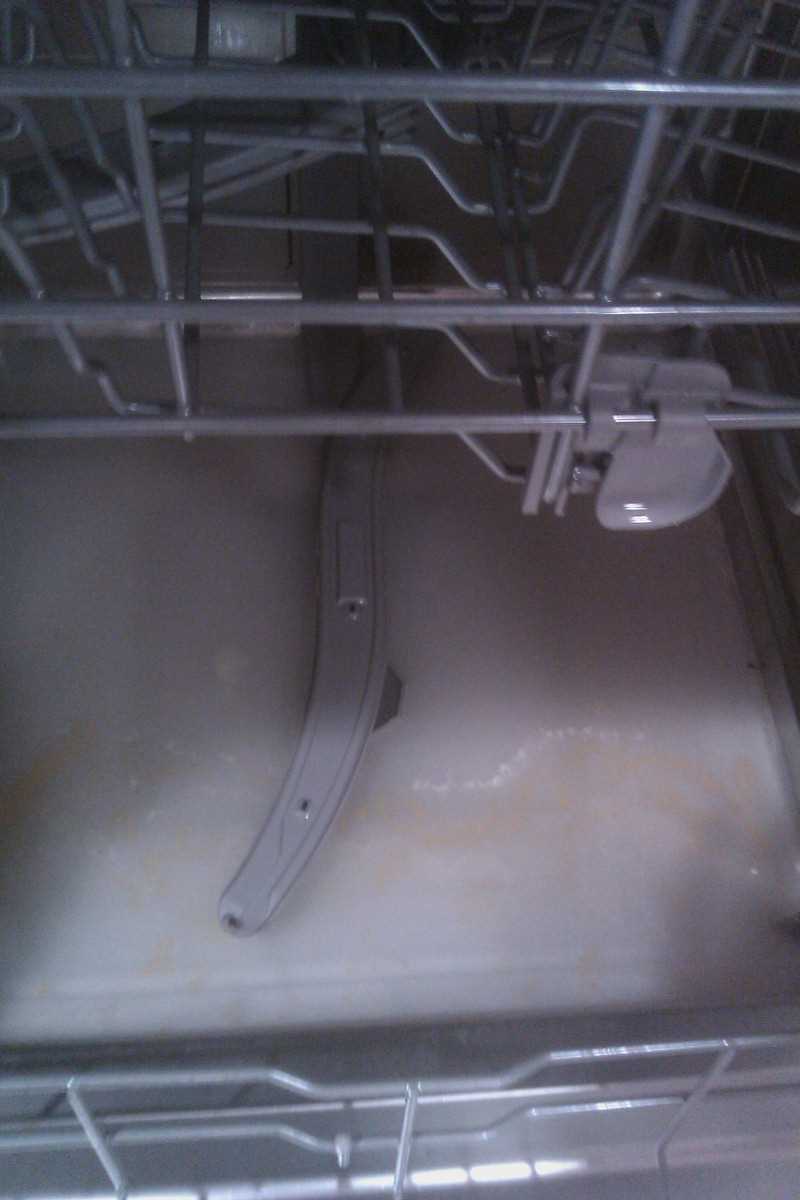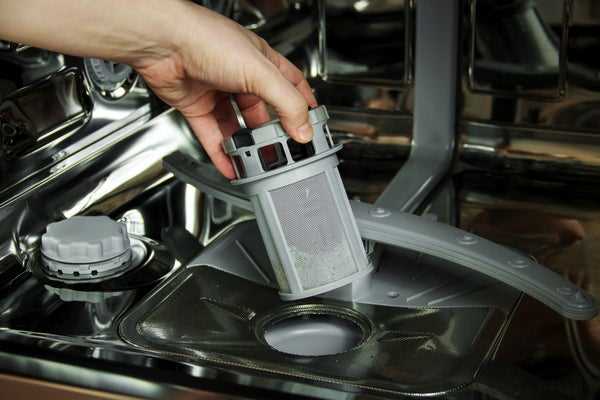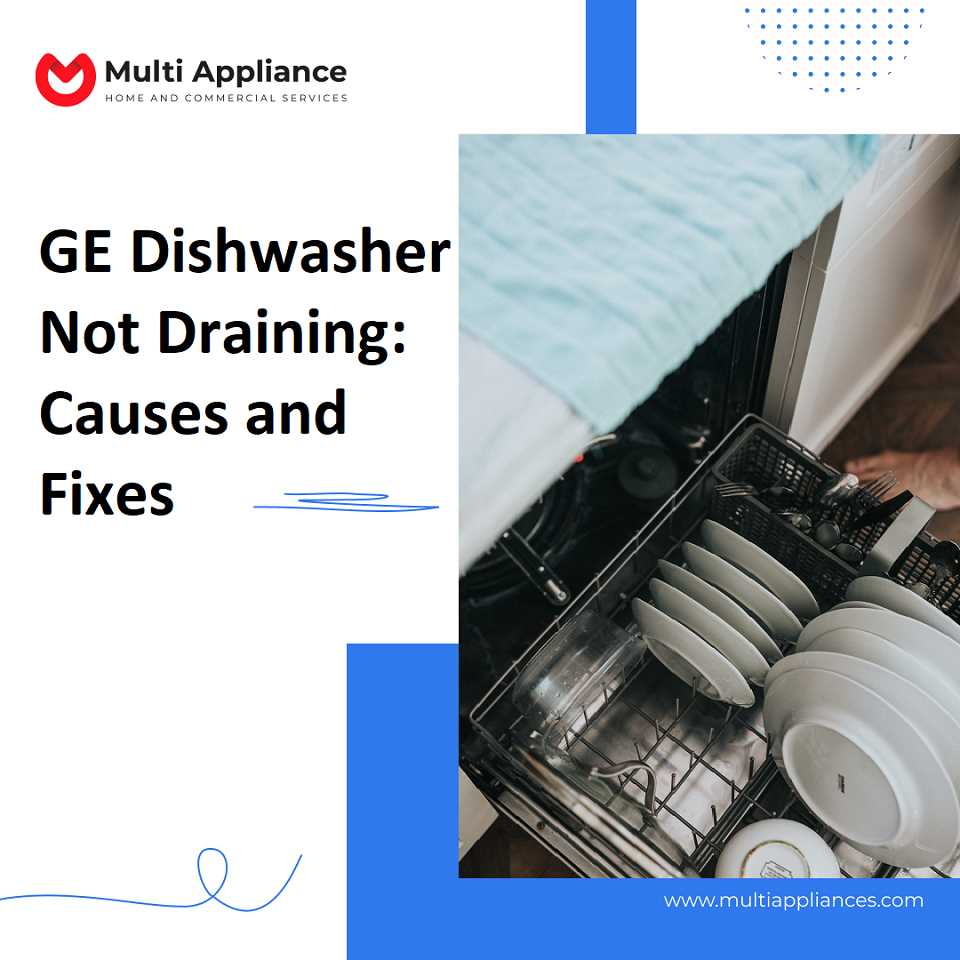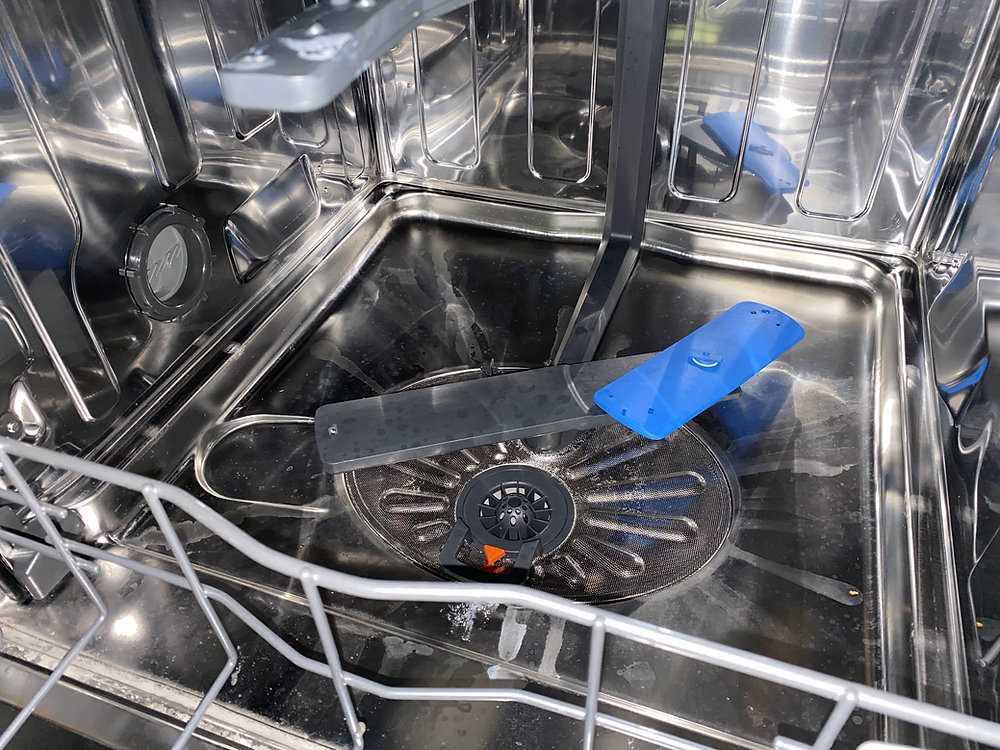




If you’ve noticed that your dishwasher is not draining properly, it can be frustrating and inconvenient. However, before you call a professional for help, there are a few things you can try on your own to fix the issue. Understanding the symptoms, causes, and possible solutions can potentially save you time and money.
One of the first signs that your dishwasher is not draining correctly is the presence of standing water at the bottom of the machine. If you open the door and see a pool of dirty water, it’s a clear indication that something is causing a blockage in the drain. Another symptom to watch out for is if your dishes are not fully clean or still show suds after a cycle. This could indicate that the drain is not able to remove all the water and detergent from the machine.
There are several possible causes for a dishwasher not draining properly. One common issue is a clogged drain hose or a blocked air gap. The drain hose is the plastic tube that connects the dishwasher to the garbage disposal or sink drain. Over time, food particles, grease, and other debris can accumulate in this hose, preventing proper drainage. Similarly, the air gap, which is usually located on the sink or countertop, can become clogged with food particles and needs to be cleaned.
Another reason your dishwasher may not be draining is a clogged drain pump or a malfunctioning drain solenoid. The drain pump is responsible for pumping water out of the machine, while the drain solenoid opens and closes to allow water to flow through. If either of these components is faulty, it can impede water drainage. Additionally, a faulty drain pump motor may not have enough power to push the water out, resulting in poor drainage or no drainage at all.
If you’re comfortable with DIY repairs and want to try fixing the issue yourself, there are a few solutions you can attempt. Before attempting any repairs, it’s essential to disconnect the dishwasher from the power supply to avoid any accidents. You can start by manually removing any visible debris or food particles from the drain and filters. Use a pair of pliers to remove any large objects that may be blocking the drain or drain pump.
If the dishwasher still won’t drain after manually clearing the blockage, you can try flushing the drain hose with water to dislodge any remaining debris. Connect the drain hose securely and pour a mixture of baking soda and vinegar or Drano into the dishwasher. Let the solution sit for a while to dissolve any clogging substances, then run a hot water wash cycle. This process can help clear the blockage and improve drainage.
If you’ve tried all the solutions mentioned above and your dishwasher still isn’t draining properly, it may be time to call a professional. Some issues, such as a frozen or damaged drain hose or faulty drain pump, may require specialized knowledge and tools to fix. A professional technician will be able to diagnose the problem and provide the most appropriate solution to get your dishwasher back in working order.
In conclusion, a dishwasher not draining can be a frustrating problem to deal with. By understanding the symptoms, causes, and possible solutions, you can save time and money by attempting to fix the issue yourself. However, if DIY repairs are not successful, it’s always best to reach out to a professional to ensure the problem is resolved correctly.
Dishwasher Not Draining Symptoms: Common Causes and Solutions
When your dishwasher isn’t draining properly, it can be frustrating and inconvenient. However, understanding the symptoms, causes, and potential solutions can help you troubleshoot and resolve the issue.
1. Check for Clogged Drains

One of the most common causes of a dishwasher not draining is a clogged drain. To check for clogs, remove any visible debris from the base of the dishwasher and clean out the filter. Sometimes, running a cycle with hot water and vinegar can help clear minor clogs.
2. Clear Obstructions in the Drain Hose
The drain hose is a long tube that connects your dishwasher to the sink or garbage disposal. If it’s clogged or obstructed, your dishwasher won’t be able to drain properly. Check the hose for any kinks, twists, or clogs, and remove any obstructions you find.
3. Inspect the Air Gap
The air gap is a small device located on top of your sink, near the faucet. Its purpose is to prevent wastewater from backing up into the dishwasher. If the air gap is clogged or dirty, it can cause drainage issues. Remove the cap, clean out any debris, and ensure that the air gap is clear and intact.
4. Examine the Dishwasher Pump

If none of the above solutions fix the problem, the issue may lie with the dishwasher pump. The pump is responsible for pumping water out of the dishwasher. Inspect the pump for any signs of damage or failure. If the pump isn’t running or is damaged, you may need to replace it.
5. Call for Professional Help
If you’ve tried these troubleshooting steps and your dishwasher still isn’t draining, it may be time to call a professional technician. They will have the expertise and tools to diagnose and fix any major or complicated issues. Additionally, some dishwasher brands offer discounts or warranties that can cover the cost of repairs.
Remember to periodically check and clean your dishwasher to prevent clogging. Using products like Drano or baking soda can help soften and remove any stinky deposits. Also, be cautious when moving the dishwasher, as the hoses and connections underneath are sensitive and need to be intact.
In conclusion, a dishwasher not draining can be a common problem that is usually fixed with some simple troubleshooting steps. By understanding the causes and knowing how to check and clear the drains, hoses, and pump, you can save time and money on repairs.
Clogged Drain Hose

One of the most common causes for a dishwasher not draining properly is a clogged drain hose. The drain hose is responsible for carrying wastewater from the dishwasher to the drain. When this hose gets clogged with food particles, grease, or other debris, it can cause the water to back up and prevent the dishwasher from draining.
Symptoms of a Clogged Drain Hose
If your dishwasher is experiencing any of the following symptoms, it may indicate a clogged drain hose:
- Water pooling at the bottom of the dishwasher
- Water not draining completely after a cycle
- A foul odor coming from the dishwasher
- Dingy or dirty dishes after a wash cycle
Causes of a Clogged Drain Hose
There are several reasons why a drain hose may become clogged:
- Food particles or debris being put into the dishwasher without rinsing them off first
- Grease or oil being poured down the kitchen sink, which can solidify and block the drain hose
- Foreign objects such as small utensils or pieces of plastic getting stuck in the hose
- An aged or faulty drain hose that has become narrow or collapsed
How to Fix a Clogged Drain Hose
If you suspect a clogged drain hose is the culprit, you can try the following tips to fix the problem:
- Manually remove any visible debris or blockages from the drain hose. This can be done by disconnecting the hose from the dishwasher and sink and using a pair of pliers to remove any objects.
- Run hot water through the drain hose to help loosen any clogs. You can also add vinegar to the water for an extra cleaning boost.
- If the clog persists, try using a pipe cleaner or a plumber’s snake to physically remove the blockage.
- Check for any kinks or bends in the hose and straighten them out if necessary.
- Inspect the dishwasher’s filter and clean it if it is dirty or clogged.
- If these DIY solutions did not solve the problem, it may be necessary to call a professional plumber or dishwasher repair technician to diagnose and fix the issue.
Preventing Future Clogs
To prevent future clogs in your dishwasher’s drain hose, consider following these tips:
- Always scrape off excess food and rinse dishes before placing them in the dishwasher.
- Regularly clean the dishwasher’s filter to remove any trapped debris.
- Avoid pouring grease or oil down the kitchen sink.
- Check the drain hose periodically for signs of wear or damage, and replace it if necessary.
- Consider using a dishwasher cleaner regularly to help remove any build-up and keep the drain hose clear.
By taking these simple steps, you can keep your dishwasher running smoothly and prevent clogged drain hoses that can lead to costly repairs.
Blocked Drain Pump
When your dishwasher isn’t draining properly, one of the possible causes could be a blocked drain pump. The drain pump is responsible for pumping out the dirty water at the end of the wash cycle. If it is blocked or not functioning properly, the water will not be able to drain out and may result in various issues.
Symptoms of a Blocked Drain Pump
- Water doesn’t drain out of the dishwasher.
- There is stagnant water at the bottom of the dishwasher after a wash cycle.
- Water leaking from the dishwasher.
- Unpleasant odor coming from the dishwasher.
Possible Causes
There are several reasons why the drain pump may become blocked:
- Food particles, grease, or debris that are too large to pass through the drain pump.
- An object or foreign material stuck in the pump, such as a broken dish or utensil.
- A clog in the drain hose or air gap.
Solutions
If you suspect that the drain pump is blocked, you can try the following solutions:
- Check for visible blockages: Start by opening the dishwasher door and inspecting the bottom of the appliance. Look for any visible debris or objects that may be obstructing the drain pump. Use a pair of pliers or tongs to remove any blockages you find.
- Clear any clogs: If there are no visible blockages, you may need to check the drain hose or air gap for clogs. Disconnect the drain hose from the dishwasher and the sink or garbage disposal. Use a long wire or a drain brush to clear any clogs.
- Remove and clean the drain pump: Sometimes, the drain pump itself can become clogged. Consult your dishwasher’s manual to locate the drain pump. Disconnect the power to the dishwasher and remove the pump. Clean it thoroughly to remove any debris or blockages.
- Check the bail and hole configuration: Depending on the model of your dishwasher, there may be a bail and hole configuration near the pump. If this is the case, make sure the hole isn’t filled with debris and that the bail is properly positioned to help prevent clogs.
- Contact a professional: If you have tried the above solutions and the issue persists, it could be a deeper problem. It is recommended to contact a professional appliance repair service to diagnose and fix the issue.
Remember, regular maintenance and periodic cleaning of your dishwasher can help prevent blockages and save you from the hassle of dealing with a non-draining dishwasher. It’s always a good idea to follow the manufacturer’s instructions and recommendations.
Faulty Drain Solenoid
- A faulty drain solenoid is one of the common causes of a dishwasher not draining properly.
- The drain solenoid is responsible for controlling the drain valve, which opens and closes to allow water to flow out of the dishwasher.
- If the drain solenoid is malfunctioning, it may not open the drain valve correctly, resulting in water not draining from the dishwasher.
Symptoms of a Faulty Drain Solenoid

- Water remains in the bottom of the dishwasher after a complete cycle.
- The dishwasher drains slowly or not at all.
Possible Causes of a Faulty Drain Solenoid

- The solenoid coil may be damaged or burned out.
- There may be a wiring issue with the solenoid.
Solutions
If you suspect a faulty drain solenoid, here are some steps you can take to troubleshoot and fix the issue:
- Disconnect the power to the dishwasher to avoid any mishaps.
- Locate the drain solenoid, which is typically located near the dishwasher’s motor assembly or drain valve.
- Inspect the solenoid for any visible damage or signs of burning. If damaged, the solenoid will need to be replaced.
- Check the wiring connected to the solenoid for any loose or damaged connections. Repair or replace any faulty wiring.
- If everything appears to be intact, the solenoid coil may still be the issue. Test the solenoid coil with a multimeter to check for continuity.
- If the solenoid coil is not functioning properly, replacing the solenoid is the recommended solution.
- Once the solenoid is fixed or replaced, reconnect the power to the dishwasher and test if the drainage issue is resolved.
If you are not comfortable troubleshooting or repairing the drain solenoid yourself, it is recommended to seek assistance from a professional dishwasher repair service. They have the knowledge and experience to handle solenoid and other dishwasher issues effectively.
Defective Drain Impeller
If your dishwasher is not draining properly, one possible cause could be a defective drain impeller. The drain impeller is a small, spinning component that helps to force water out of the dishwasher during the draining process.
About the Drain Impeller
The drain impeller is located at the bottom of your dishwasher, in the area where water collects. It is connected to the dishwasher’s drain pump, which is responsible for removing water from the dishwasher. When the drain impeller spins, it creates suction that pulls water through the drain pump and out of the dishwasher.
Symptoms of a Defective Drain Impeller
- Your dishwasher is not draining water properly or at all.
- Water is pooling at the bottom of the dishwasher.
- Your dishwasher may emit a stinky smell due to standing water.
- You may notice food particles or debris not being fully drained out.
Causes and Solutions for a Defective Drain Impeller
If you suspect that your dishwasher’s drain impeller is faulty, there are a few steps you can take to diagnose and resolve the issue.
- Inspect the Drain Impeller: Start by turning off the power to your dishwasher and removing the bottom rack. Find the drain impeller, which is usually located near the front of the dishwasher. Use a flashlight to examine it for any visible damage or blockages from food particles. If you see any issues, like cracks or excessive debris, the impeller may need to be replaced.
- Check the Connections: Examine the wiring and hoses connected to the drain impeller. Make sure they’re not damaged or disconnected. If you find any issues, such as loose connections or frayed wires, you may need to repair or replace them.
- Clean the Drain Impeller: If the drain impeller appears to be in good condition and there are no issues with the connections, it may simply be clogged. Use needle-nose pliers or a similar tool to remove any debris or blockages from the impeller. Be gentle to avoid causing further damage.
- Test the Drain Function: Once you’ve cleaned the drain impeller, reassemble everything and run a test cycle to see if the draining problem has been resolved. Allow the dishwasher to drain completely and check for any leaks or pooling water. If the issue persists, further troubleshooting or professional assistance might be required.
Remember, fixing a faulty drain impeller can vary depending on the brand and model of your dishwasher. If you’re unsure about performing any repairs yourself, it’s always best to consult the manufacturer’s instructions or contact a professional technician for assistance.
By following these helpful tips, you should be able to diagnose and solve a defective drain impeller issue in your dishwasher.
Malfunctioning Dishwasher Control Board
If your dishwasher is not draining properly, one of the potential causes could be a malfunctioning control board. The control board is the brain of your dishwasher and controls all the functions and cycles. When it malfunctions, it can cause a variety of drainage issues.
Here are a few symptoms that may indicate a malfunctioning control board:
- The dishwasher is not draining at all
- There is standing water at the bottom of the dishwasher after the cycle
- The dishwasher is draining slowly
- There is a stinky odor coming from the dishwasher
Possible Causes
There are several potential causes for a malfunctioning control board in a dishwasher:
- Age: Dishwashers have a typical lifespan of around 10 years. If your dishwasher is older, the control board may be nearing the end of its life.
- Wiring Issues: The wiring connecting the control board to other components of the dishwasher may have become loose or damaged, affecting its functionality.
- Detergent Residue: Over time, detergent residue can build up on the control board, causing it to malfunction.
Solutions
If you suspect that your dishwasher control board is malfunctioning, there are a few steps you can take to troubleshoot and potentially resolve the issue:
- Check for loose or damaged wiring: Inspect the wiring connecting the control board to other components of the dishwasher. If you notice any loose or damaged wires, they may need to be repaired or replaced.
- Clean the control board: Gently clean the control board with a soft cloth and a mild detergent. Be careful not to use too much water or liquid, as this can damage the control board.
- Reset the control board: Some dishwasher models have a reset button or a specific sequence of buttons that can be pressed to reset the control board. Refer to your dishwasher’s manual for instructions.
- Replace the control board: If all else fails, you may need to replace the control board. Consult a professional or refer to your dishwasher’s manual for guidance on how to do this.
Remember, if you’re not comfortable working with electrical components or if the issue persists, it’s always best to call a professional appliance repair technician to diagnose and solve the problem.
FAQ
Why is my dishwasher not draining?
There could be several reasons why your dishwasher isn’t draining. It could be due to a clog in the drain hose, a faulty drain pump, or a blockage in the sink drain. It’s best to check these areas and clean them if necessary.
How can I fix a clog in the drain hose?
If you suspect a clog in the drain hose, you can try removing the hose from the dishwasher and the sink drain and flushing it with water to remove any blockages. If that doesn’t work, you may need to replace the hose.
Why is my dishwasher still not draining even after I’ve cleaned the drain hose?
If your dishwasher is still not draining after cleaning the drain hose, there could be a problem with the drain pump. The pump may be blocked or faulty, and it may need to be replaced to fix the issue.
Can a clogged garbage disposal affect dishwasher drainage?
Yes, a clogged garbage disposal can affect the drainage of your dishwasher. The dishwasher drain hose is often connected to the garbage disposal, so if the disposal is clogged, it can prevent water from draining properly. Clearing the clog in the disposal should resolve the draining issue.
What should I do if water is pooling at the bottom of my dishwasher?
If water is pooling at the bottom of your dishwasher, it’s likely that there is a clog somewhere in the drainage system. Check the drain hose and the sink drain for any blockages and clean them if necessary. If the problem persists, you may need to call a professional to inspect and repair the dishwasher.
Is it normal for a dishwasher to have a small amount of water at the bottom after a cycle?
A small amount of water at the bottom of the dishwasher after a cycle is normal. However, if there is a significant amount of water that doesn’t drain, it could indicate a drainage problem. In that case, you should check for any clogs or issues with the drain hose or pump.
Why does my dishwasher smell bad when it doesn’t drain?
A dishwasher that doesn’t drain properly can become a breeding ground for bacteria, which can cause unpleasant odours. The stagnant water and trapped food particles can create a foul smell. To get rid of the smell, you should clean and unclog the dishwasher’s drainage system and run a cycle with vinegar to remove any lingering odours.











